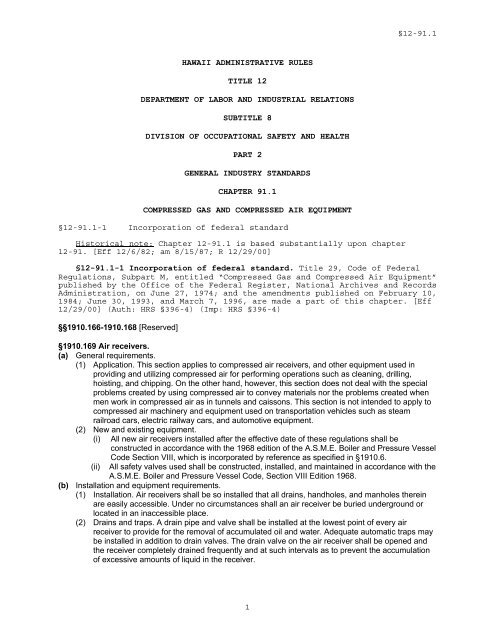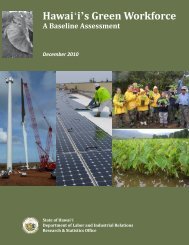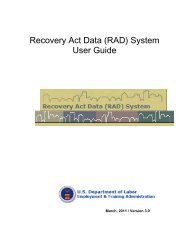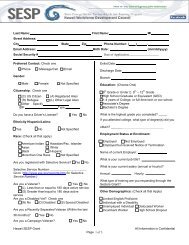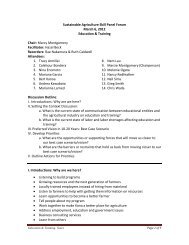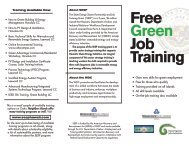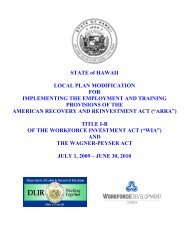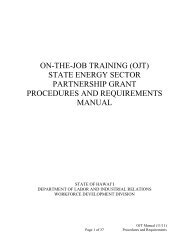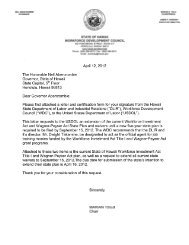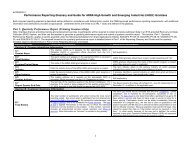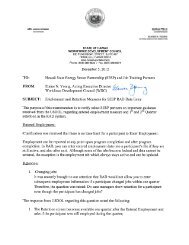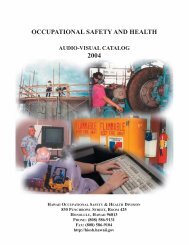12-91.1 1 hawaii administrative rules title 12 department of labor ...
12-91.1 1 hawaii administrative rules title 12 department of labor ...
12-91.1 1 hawaii administrative rules title 12 department of labor ...
Create successful ePaper yourself
Turn your PDF publications into a flip-book with our unique Google optimized e-Paper software.
HAWAII ADMINISTRATIVE RULES<br />
TITLE <strong>12</strong><br />
DEPARTMENT OF LABOR AND INDUSTRIAL RELATIONS<br />
SUBTITLE 8<br />
DIVISION OF OCCUPATIONAL SAFETY AND HEALTH<br />
PART 2<br />
GENERAL INDUSTRY STANDARDS<br />
CHAPTER <strong>91.1</strong><br />
COMPRESSED GAS AND COMPRESSED AIR EQUIPMENT<br />
§<strong>12</strong>-<strong>91.1</strong>-1 Incorporation <strong>of</strong> federal standard<br />
Historical note: Chapter <strong>12</strong>-<strong>91.1</strong> is based substantially upon chapter<br />
<strong>12</strong>-91. [Eff <strong>12</strong>/6/82; am 8/15/87; R <strong>12</strong>/29/00]<br />
1<br />
§<strong>12</strong>-<strong>91.1</strong><br />
§<strong>12</strong>-<strong>91.1</strong>-1 Incorporation <strong>of</strong> federal standard. Title 29, Code <strong>of</strong> Federal<br />
Regulations, Subpart M, en<strong>title</strong>d “Compressed Gas and Compressed Air Equipment”<br />
published by the Office <strong>of</strong> the Federal Register, National Archives and Records<br />
Administration, on June 27, 1974; and the amendments published on February 10,<br />
1984; June 30, 1993, and March 7, 1996, are made a part <strong>of</strong> this chapter. [Eff<br />
<strong>12</strong>/29/00] (Auth: HRS §396-4) (Imp: HRS §396-4)<br />
§§1910.166-1910.168 [Reserved]<br />
§1910.169 Air receivers.<br />
(a) General requirements.<br />
(1) Application. This section applies to compressed air receivers, and other equipment used in<br />
providing and utilizing compressed air for performing operations such as cleaning, drilling,<br />
hoisting, and chipping. On the other hand, however, this section does not deal with the special<br />
problems created by using compressed air to convey materials nor the problems created when<br />
men work in compressed air as in tunnels and caissons. This section is not intended to apply to<br />
compressed air machinery and equipment used on transportation vehicles such as steam<br />
railroad cars, electric railway cars, and automotive equipment.<br />
(2) New and existing equipment.<br />
(i) All new air receivers installed after the effective date <strong>of</strong> these regulations shall be<br />
constructed in accordance with the 1968 edition <strong>of</strong> the A.S.M.E. Boiler and Pressure Vessel<br />
Code Section VIII, which is incorporated by reference as specified in §1910.6.<br />
(ii) All safety valves used shall be constructed, installed, and maintained in accordance with the<br />
A.S.M.E. Boiler and Pressure Vessel Code, Section VIII Edition 1968.<br />
(b) Installation and equipment requirements.<br />
(1) Installation. Air receivers shall be so installed that all drains, handholes, and manholes therein<br />
are easily accessible. Under no circumstances shall an air receiver be buried underground or<br />
located in an inaccessible place.<br />
(2) Drains and traps. A drain pipe and valve shall be installed at the lowest point <strong>of</strong> every air<br />
receiver to provide for the removal <strong>of</strong> accumulated oil and water. Adequate automatic traps may<br />
be installed in addition to drain valves. The drain valve on the air receiver shall be opened and<br />
the receiver completely drained frequently and at such intervals as to prevent the accumulation<br />
<strong>of</strong> excessive amounts <strong>of</strong> liquid in the receiver.
§<strong>12</strong>-<strong>91.1</strong><br />
(3) Gages and valves.<br />
(i) Every air receiver shall be equipped with an indicating pressure gage (so located as to be<br />
readily visible) and with one or more spring-loaded safety valves. The total relieving<br />
capacity <strong>of</strong> such safety valves shall be such as to prevent pressure in the receiver from<br />
exceeding the maximum allowable working pressure <strong>of</strong> the receiver by more than 10<br />
percent.<br />
(ii) No valve <strong>of</strong> any type shall be placed between the air receiver and its safety valve or valves.<br />
(iii) Safety appliances, such as safety valves, indicating devices and controlling devices, shall<br />
be constructed, located, and installed so that they cannot be readily rendered inoperative by<br />
any means, including the elements.<br />
(iv) All safety valves shall be tested frequently and at regular intervals to determine whether<br />
they are in good operating condition.<br />
2


